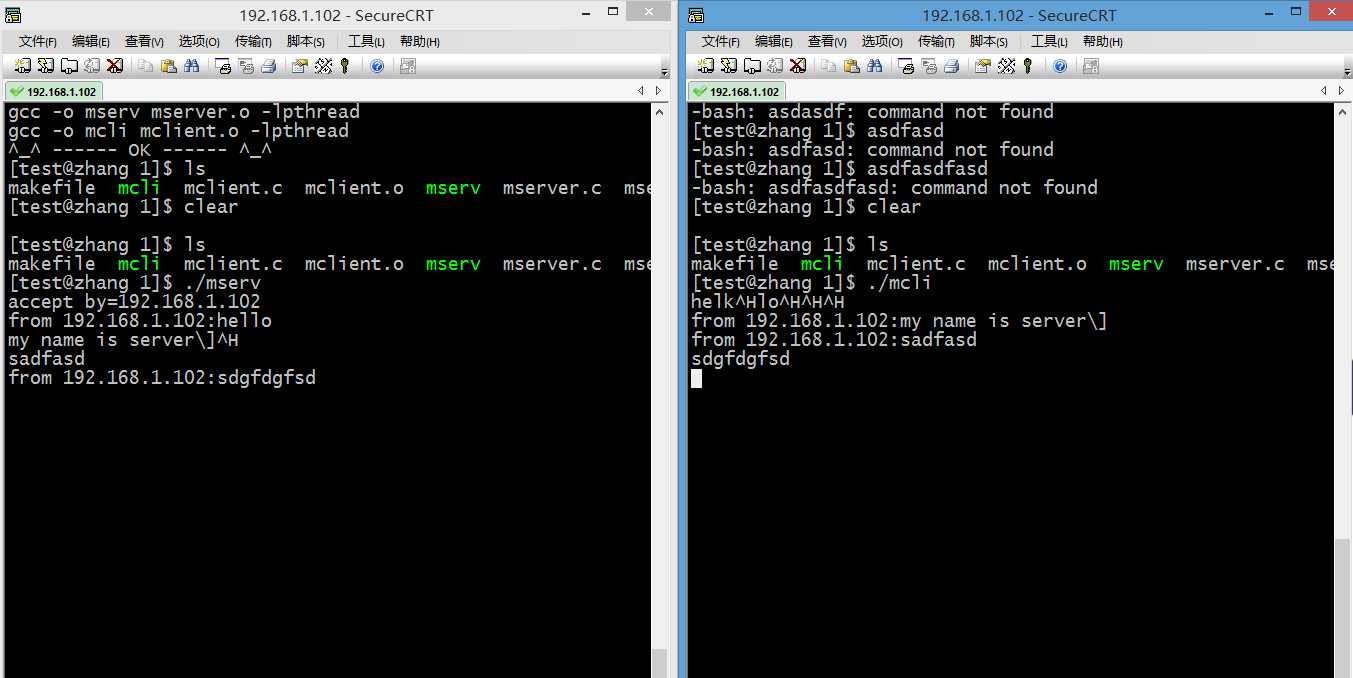Linux 网络编程(socket多线程升级版)
Posted
tags:
篇首语:本文由小常识网(cha138.com)小编为大家整理,主要介绍了Linux 网络编程(socket多线程升级版)相关的知识,希望对你有一定的参考价值。
//网络编程--客户端 #include <stdio.h> #include <stdlib.h> #include <string.h> #include <unistd.h> #include <errno.h> #include <sys/types.h> #include <sys/socket.h> #include <pthread.h> #include <netinet/in.h> #include <arpa/inet.h> /* 强调:不论在服务器端还是客户端send()和recv()函数中的套接口都是客户端的套接口,不是服务器端的, 这也证明了网络套接口是全双工的,在一个网络管道中的两端,每端都可以进行读写操作。 */ typedef struct _recvmodel { int st; struct sockaddr_in * addr; } RecvModel; //send message void * send_thread(void *arg) { if (arg == NULL) { printf("param is not allow NULL!\n"); return NULL; } int st = *(int *) arg; char buf[1024] = { 0 }; while (1) { read(STDIN_FILENO, buf, sizeof(buf)); if (send(st, buf, strlen(buf), 0) == -1) { printf("send failed ! error message %s\n", strerror(errno)); return NULL; } memset(buf, 0, sizeof(buf)); } return NULL; } //recv message void * recv_thread(void * arg) { if (arg == NULL) { printf("param is not allow NULL!\n"); return NULL; } RecvModel * model = (RecvModel *) arg; int flag = 0; char buf[1024] = { 0 }; while (1) { flag = recv(model->st, buf, sizeof(buf), 0); if (flag == 0) { printf("对方已经关闭连接!\n"); return NULL; } else if (flag == -1) { printf("recv failed ! error message : %s\n", strerror(errno)); return NULL; } printf("from %s:%s", inet_ntoa(model->addr->sin_addr), buf); memset(buf, 0, sizeof(buf)); } return NULL; } int main(int arg, char *args[]) { //打开socket int st = socket(AF_INET, SOCK_STREAM, 0); if (st == -1) { printf("open socket failed! error message:%s\n", strerror(errno)); return -1; } //定义IP地址结构 struct sockaddr_in addr; memset(&addr, 0, sizeof(addr)); //设置TCP/IP连接 addr.sin_family=AF_INET; //设置端口号 addr.sin_port = htons(8080); //设置允许连接地址 addr.sin_addr.s_addr = inet_addr("192.168.1.102"); //connect server int numx = connect(st, (struct sockaddr *) &addr, sizeof(addr)); if (numx == -1) { printf("connect server failed ! error message :%s\n", strerror(errno)); goto END; } RecvModel model; model.st = st; model.addr = &addr; //开启多线程--线程1接收消息,线程2发送消息 pthread_t thr1, thr2; if (pthread_create(&thr1, NULL, send_thread, &st) != 0) { printf("create thread failed ! \n"); goto END; } if (pthread_create(&thr2, NULL, recv_thread, &model) != 0) { printf("create thread failed ! \n"); goto END; } pthread_join(thr1, NULL); pthread_join(thr2, NULL); END: close(st); return 0; }
//网络编程--服务端 #include <stdio.h> #include <stdlib.h> #include <string.h> #include <unistd.h> #include <errno.h> #include <sys/types.h> #include <sys/socket.h> #include <pthread.h> #include <netinet/in.h> #include <arpa/inet.h> typedef struct _recvmodel { int st; struct sockaddr_in * addr; } RecvModel; //send message void * send_thread(void *arg) { if (arg == NULL) { printf("param is not allow NULL!\n"); return NULL; } int st = *(int *) arg; char buf[1024] = { 0 }; while (1) { read(STDIN_FILENO, buf, sizeof(buf)); if (send(st, buf, strlen(buf), 0) == -1) { printf("send failed ! error message %s\n", strerror(errno)); return NULL; } memset(buf, 0, sizeof(buf)); } return NULL; } //recv message void * recv_thread(void * arg) { if (arg == NULL) { printf("param is not allow NULL!\n"); return NULL; } RecvModel * model = (RecvModel *) arg; int flag = 0; char buf[1024] = { 0 }; while (1) { flag = recv(model->st, buf, sizeof(buf), 0); if (flag == 0) { printf("对方已经关闭连接!\n"); return NULL; } else if (flag == -1) { printf("recv failed ! error message : %s\n", strerror(errno)); return NULL; } printf("from %s:%s", inet_ntoa(model->addr->sin_addr), buf); memset(buf, 0, sizeof(buf)); } return NULL; } int main(int arg, char *args[]) { //short port = atoi(args[1]); //打开socket int st = socket(AF_INET, SOCK_STREAM, 0); if (st == -1) { printf("open socket failed! error message:%s\n", strerror(errno)); return -1; } //设置系统地址可重用 int on = 1; if (setsockopt(st, SOL_SOCKET, SO_REUSEADDR, &on, sizeof(on)) == -1) { printf("setsockpot failed ! error message %s\n", strerror(errno)); goto END; } //定义IP地址结构 struct sockaddr_in addr; memset(&addr, 0, sizeof(addr)); //设置TCP/IP连接 addr.sin_family = AF_INET; //设置端口号 addr.sin_port = htons(8080); //设置允许连接地址 addr.sin_addr.s_addr = htonl(INADDR_ANY); //bind ip if (bind(st, (struct sockaddr *) &addr, sizeof(addr)) == -1) { printf("bind ip failed ! error message :%s\n", strerror(errno)); goto END; } //监听连接 if (listen(st, 20) == -1) { printf("listen failed ! error message :%s\n", strerror(errno)); goto END; } //接收客户端连接(阻塞) struct sockaddr_in client_addr; memset(&client_addr, 0, sizeof(client_addr)); socklen_t client_addrlen = sizeof(client_addr); int client_st = accept(st, (struct sockaddr *) &client_addr, &client_addrlen); if (client_st == -1) { printf("accept failed ! error message :%s\n", strerror(errno)); goto END; } RecvModel model; model.st = client_st; model.addr = &client_addr; printf("accept by=%s\n",inet_ntoa(client_addr.sin_addr)); //开启多线程--线程1接收消息,线程2发送消息 pthread_t thr1, thr2; if (pthread_create(&thr1, NULL, send_thread, &client_st) != 0) { printf("create thread failed ! \n"); goto END; } if (pthread_create(&thr2, NULL, recv_thread, &model) != 0) { printf("create thread failed ! \n"); goto END; } pthread_join(thr1, NULL); pthread_join(thr2, NULL); //关闭客户端管道 close(client_st); END: close(st); return 0; }
.SUDDIXES:.c .o CC=gcc SRCS1=mserver.c SRCS2=mclient.c OBJS1=$(SRCS1:.c=.o) OBJS2=$(SRCS2:.c=.o) EXEC1=mserv EXEC2=mcli start:$(OBJS1) $(OBJS2) $(CC) -o $(EXEC1) $(OBJS1) -lpthread $(CC) -o $(EXEC2) $(OBJS2) -lpthread @echo "^_^ ------ OK ------ ^_^" .c.o: $(CC) -Wall -g -o [email protected] -c $< clean: rm -f $(OBJS1) rm -f $(OBJS2) rm -f $(EXEC1) rm -f $(EXEC2)
小结:这段升级版程序花费3小时,出现一个错误提示:" Transport endpoint is not connected",我仔细查找资料,
网上说是socket套接字不对,可我程序中套接字是正确的,
我没有办法,但是我有一个成功的程序,就是第一版socket程序,我将原来的socket程序复制到我的新程序中,一句句替换,终于发现这个问题
问题:我缺少addr.sin_family = AF_INET;//将网络地址类型设置为TCP/IP协议;这句代码。缺少这段代码是导致报错的主要原因。
另外注意我代码中强调的内容--网络管道是全双工的

以上是关于Linux 网络编程(socket多线程升级版)的主要内容,如果未能解决你的问题,请参考以下文章